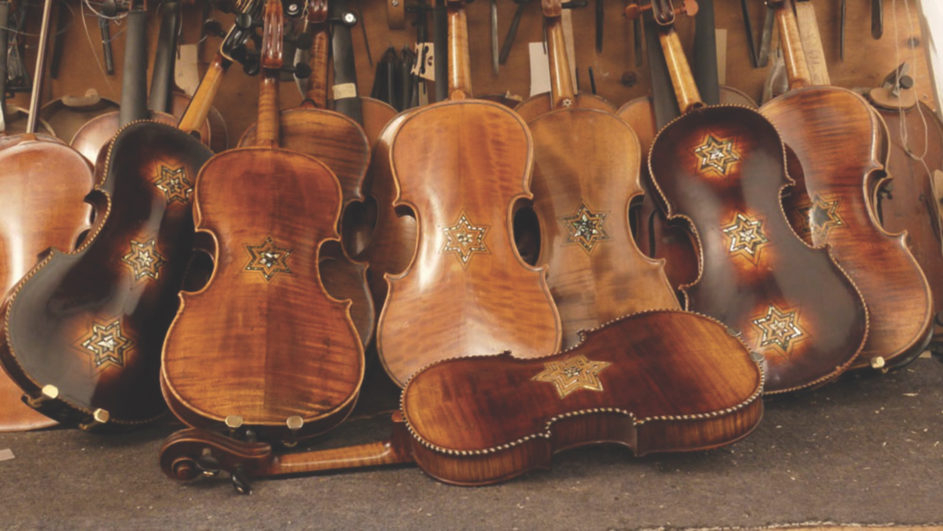Stories of the Holocaust have been told through books, music, plays, visual art, films and television. An exhibit Jan. 4-27 at the UT Downtown Gallery will share stories of the Holocaust using restored violins.
The gallery will host “Violins of Hope,” an exhibition of violins owned by Jewish musicians before and/or during the Holocaust and acquired and restored by Israeli master luthier Amnon Weinstein. The exhibit debuts with special hours, 5-9 p.m. Friday, Jan. 4, at the gallery as part of Knoxville’s First Friday. At 2 p.m. Jan. 4, Knoxville Mayor Madeline Rogero will take part in a ribbon cutting for the exhibit.
In addition, the Knoxville Symphony Orchestra, with guest Hallerin Hilton Hill, will perform a “Violins of Hope: Strings of the Holocaust” concert at 7 p.m. Wednesday-Thursday, Jan. 23-24, at the Tennessee Theatre. Also, author Peter Aronson will give a lecture on his Holocaust-related children’s book at 3:30 p.m. Jan. 24 at the University of Tennessee’s Hodges Library Auditorium.
Amnon Weinstein’s father, Moshe Weinstein, born in 1909 in Poland, studied violin at a conservatory before training as a violin maker. He immigrated to British Palestine in 1938 and founded a luthier business in Tel Aviv, where Amnon was born. It was Moshe Weinstein who began collecting violins when musicians angry about the treatment of Jews in Germany started destroying or getting rid of their German-made instruments. He learned after World War II that all of his relatives in Europe had been murdered by the Nazis.

Amnon Weinstein (from the “Violins of Hope” website)
Amnon Weinstein, who plays viola and trumpet, trained as a luthier with his father before studying with master luthiers in Cremona, Italy, and Paris. His son, Avshalom, joined the family business and is based in Istanbul, Turkey.
More than six million Jews were killed by the Nazis during the Holocaust. Music was a key factor in the hope for survival. It was also used as a cruel distraction by the Nazis.
According to Wikipedia, in the 1980s, a young man brought an instrument to Amnon Weinstein for restoration. The man’s grandfather survived the Holocaust because his job was to play the violin while Nazi soldiers marched others to their deaths. When Weinstein opened the violin case, he saw black powder – ashes that had made their way in from the chimneys of the crematoria at Auschwitz. He thought of his own relatives who had perished and was overwhelmed. He could not bring himself to begin restoring the violins.
In 1996, Weinstein decided he was ready. The Downtown Gallery website says, “He put out a call for violins from the Holocaust that he would restore in hopes that the instruments would sound again. He started locating violins that were played by Jews in the camps and ghettos, painstakingly piecing them back together so they could be brought to life again on the concert stage. Although most of the musicians who originally played the instruments were silenced by the Holocaust, their voices and spirits live on through the violins that Amnon has lovingly restored.”
Amnon and Avshalom Weinstein restored and own the collection of more than 60 violins, violas and cellos, many of which have been used in “Violins of Hope” concerts like the upcoming Knoxville Symphony one. Amnon Weinstein initiated the first major concerts in Jerusalem and Istanbul in 2008. Since then, performances have taken place in Switzerland, Spain, Monaco, Italy, Germany, Mexico, Romania and the United States, including a concert in Nashville last March.

Peter Aronson (from the UT Downtown Gallery website)
In conjunction with “Violins of Hope,” the UT Downtown Gallery will bring journalist and lawyer Peter Aronson to give a lecture on his children’s book, “Bronislaw Huberman, From Child Prodigy to Hero, the Violinist who saved Jewish Musicians from the Holocaust” on Thursday, Jan. 24. Polish Jewish virtuoso Huberman founded the Palestine Philharmonic Orchestra (later called the Israeli Philharmonic Orchestra) in 1936, recruiting leading Jewish musicians from Europe. Their immigration ended up saving the lives of at least 1,000 musicians and their family members.
The “Violins of Hope” exhibit at the UT Downtown Gallery will be open 11 a.m.-6 p.m. weekdays, 10 a.m.-3 p.m. Saturdays and 1-4 p.m. Sundays through Jan. 27.

Aronson’s book
The Stanford Eisenberg Knoxville Jewish Day School presents the Knoxville Symphony’s performance of “Violins of Hope: Strings From the Holocaust” at 7 p.m. Wednesday and Thursday, Jan. 23-24, at the Tennessee Theatre, 604 S. Gay St.
Author Aronson will give a lecture on his book at 3:30 p.m. Thursday, Jan. 24, at the Hodges Library Auditorium, 1015 Volunteer Blvd. (See parking regulations here.)

